This Indian eggplant curry recipe is one of my favorite comfort food dishes of all time. It is an effortless preparation with meltingly tender eggplant and a luscious sauce loaded with big Indian flavors. Indian cooking at its best!
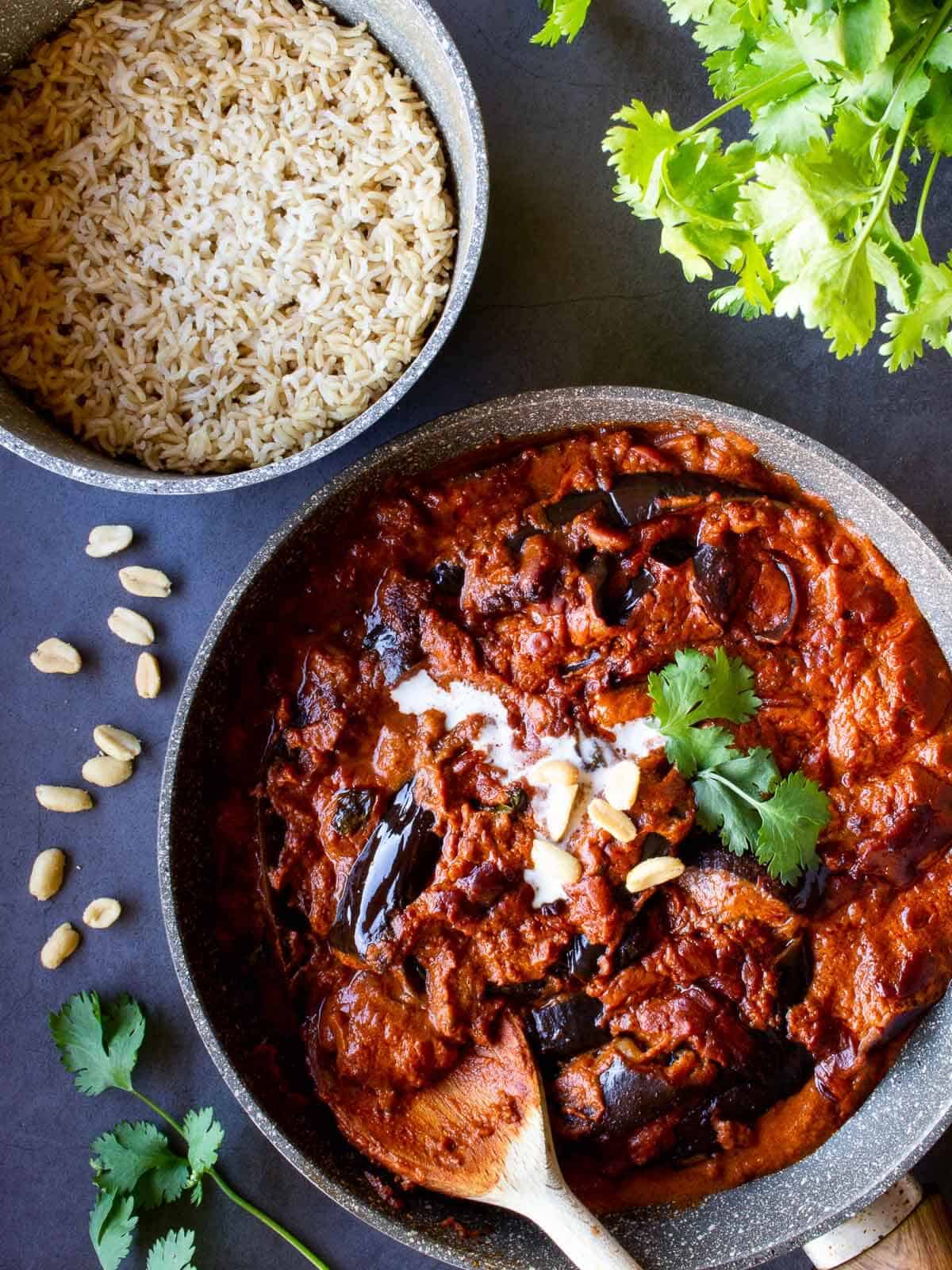
This easy curry puts a smile on our faces every time we make it; definitely one of our favorite Indian-inspired eggplant dishes. We had it three times this past week! Like our Indian cauliflower curry, Indian Brussels sprouts curry, and vegetable tikka masala, also use garam masala!
Jump to:
💚 Why we love this dish
- You make this eggplant curry in one pot.
- Minimal babysitting - It only needs to be checked twice during the whole making.
- You only need a few ingredients that are very easy to find.
- This eggplant recipe is soft and silky, and you can pair it with your favorite choice of flatbread naan or basmati rice.
- Easy to use leftovers - we use eggplant curry leftovers as burritos or involtini fillings.
- It makes a great vegan fall recipe, as it is cozy and packed with flavor.
🧾 Ingredients
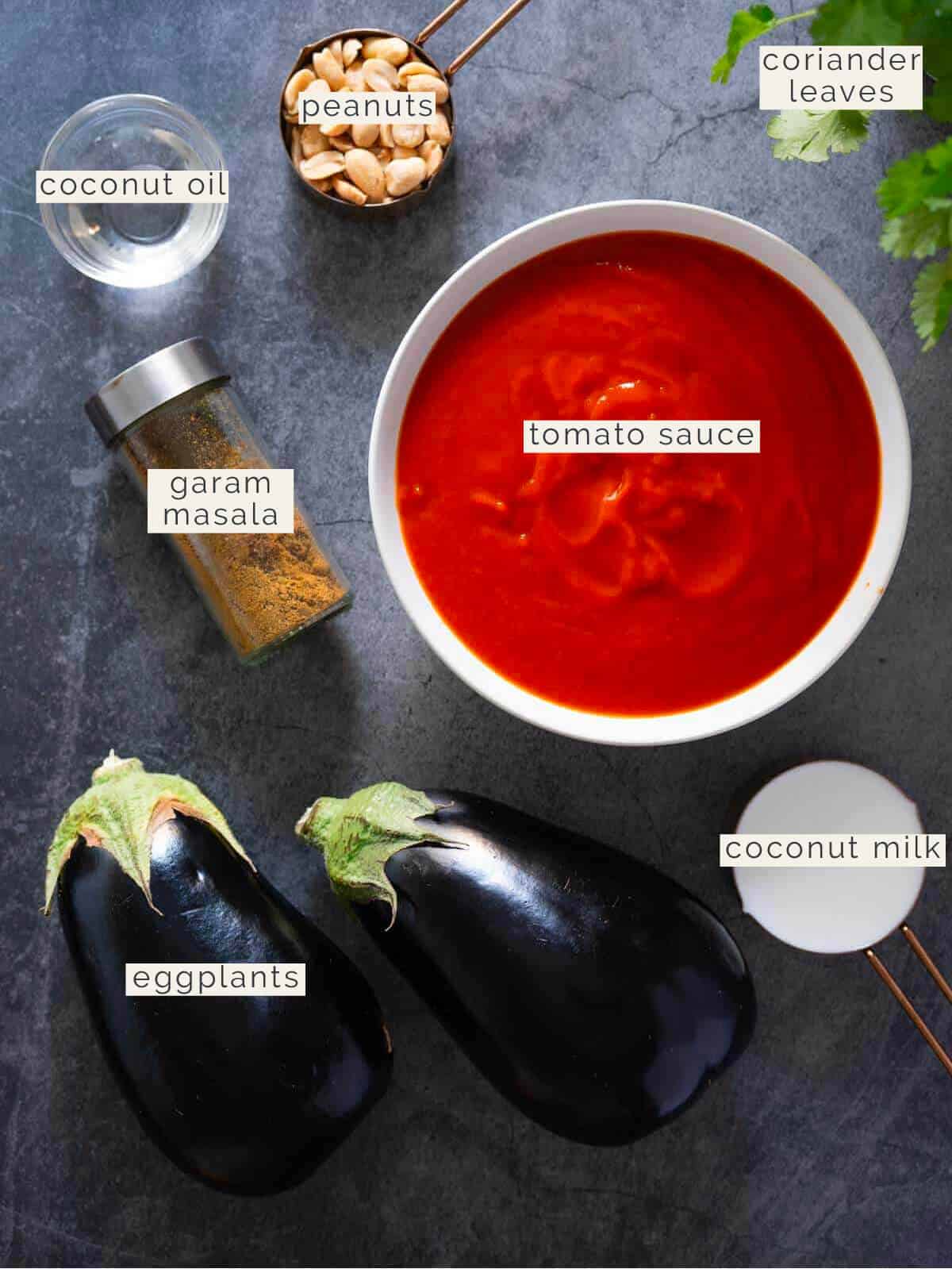
- Eggplant: This veggie is the star of the dish, offering a meaty texture and absorbing flavors like a sponge. Plus, it's low in calories and high in fiber, making it a nutritional win.
- Coconut Oil: We use it for its high smoke point, perfect for sautéing and frying. Its subtle coconut flavor also elevates the tropical notes in the dish.
- Tomato Pulp: This adds a tangy richness and serves as the base for our sauce. Whether you use diced, crushed, or passata, it's all about creating that luscious texture.
- Peanuts: These little guys add a crunchy contrast and are packed with protein. They also bring in a nutty flavor that complements the spices beautifully.
- Shredded Coconut: This ingredient is all about texture and flavor. It adds a tropical twist and a bit of crunch, making each bite more interesting.
- Garam Masala or Madras Curry: Spice is the life of the party here. These blends offer a complex flavor profile, ranging from sweet to spicy, and can be easily swapped based on what you have.
- Fresh Coriander Leaves: These add freshness and color to the dish. Coriander powder can also do the trick if you're out of fresh leaves.
- Coconut Milk: This brings everything together, adding creaminess and a hint of sweetness. It also helps balance the spices, making the dish indulgent yet light.
Substitutions
| Original Ingredient | Suggested Substitutions |
|---|---|
| Eggplants | Asian, Japanese, Italian |
| Curry powder | Madras curry, garam masala, curry powder |
| Coriander | Parsley leaves, coriander powder |
| Tomato puree | Diced whole tomatoes, tomato paste |
🍽 Equipment
Large saucepan and a wooden spoon. If you choose to lessen the bitterness of the eggplants, a wire rack would be ideal, similar to what you'd use for cooling cookies.
🔪 Instructions
Cooking Indian Eggplant is easy. You just need to be patient to achieve the best texture. It does not require babysitting but requires some time.
The creaminess of the eggplants comes from the technique used. Are you ready to take your cooking skills to the next level?
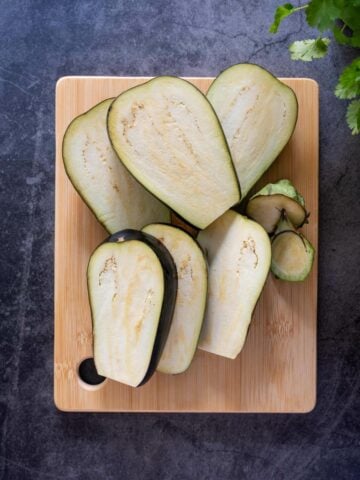
- Slice eggplants lengthwise into ½" (1 cm) slices. Remove the tops.

- In a large saucepan, gently toast the peanuts and the shredded coconut in hot oil on medium heat. Ensure they only get golden brown; it should take about 30 seconds.

- Add the garam masala curry powder to the saucepan.
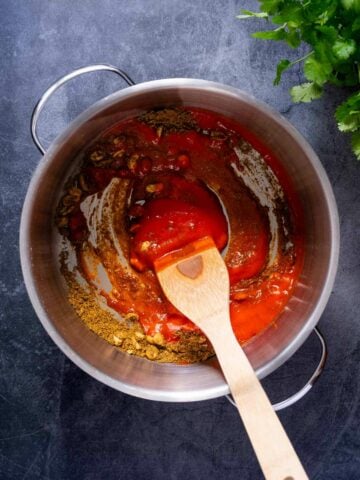
- Stir in half of the tomato passata and stir for 2 minutes.
Hint: you can also use two tablespoons of peanut butter to substitute for peanuts.
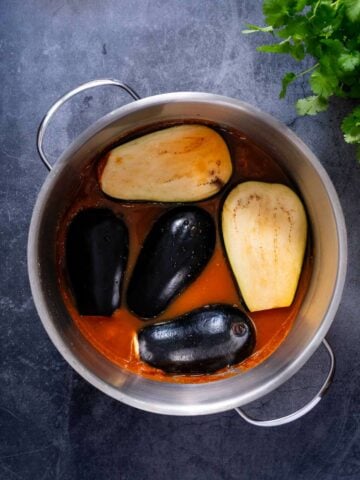
- Place the eggplant slices on top of the mix. Stir a bit and add 1 cup of water. Close with a lid. (Don’t worry if the eggplants are not fully covered). Bring the heat to a minimum and leave it closed for 30 minutes.
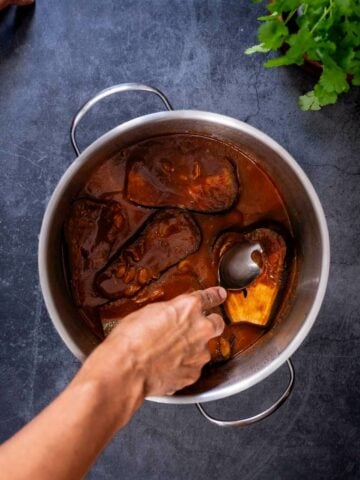
- Turn the eggplants and smash them with the back of a spoon. Close the lid and cook on medium-high heat for another 10 minutes, stirring it halfway through.

- Open the lid, stir a bit, and add the coconut milk, the rest of the tomato purée, salt, and cayenne pepper (or black pepper).
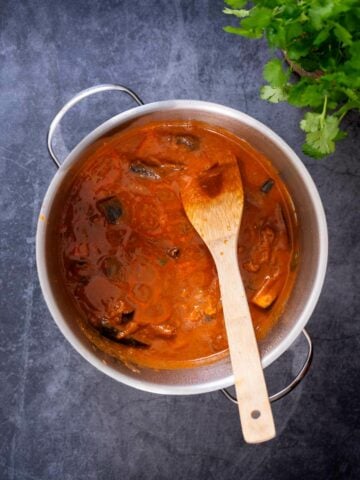
- Let the curry simmer for 10 minutes and remove from heat.
Turn the heat off and let the lid on to let all the flavors come together before garnishing the eggplant curry with fresh coriander finely chopped.
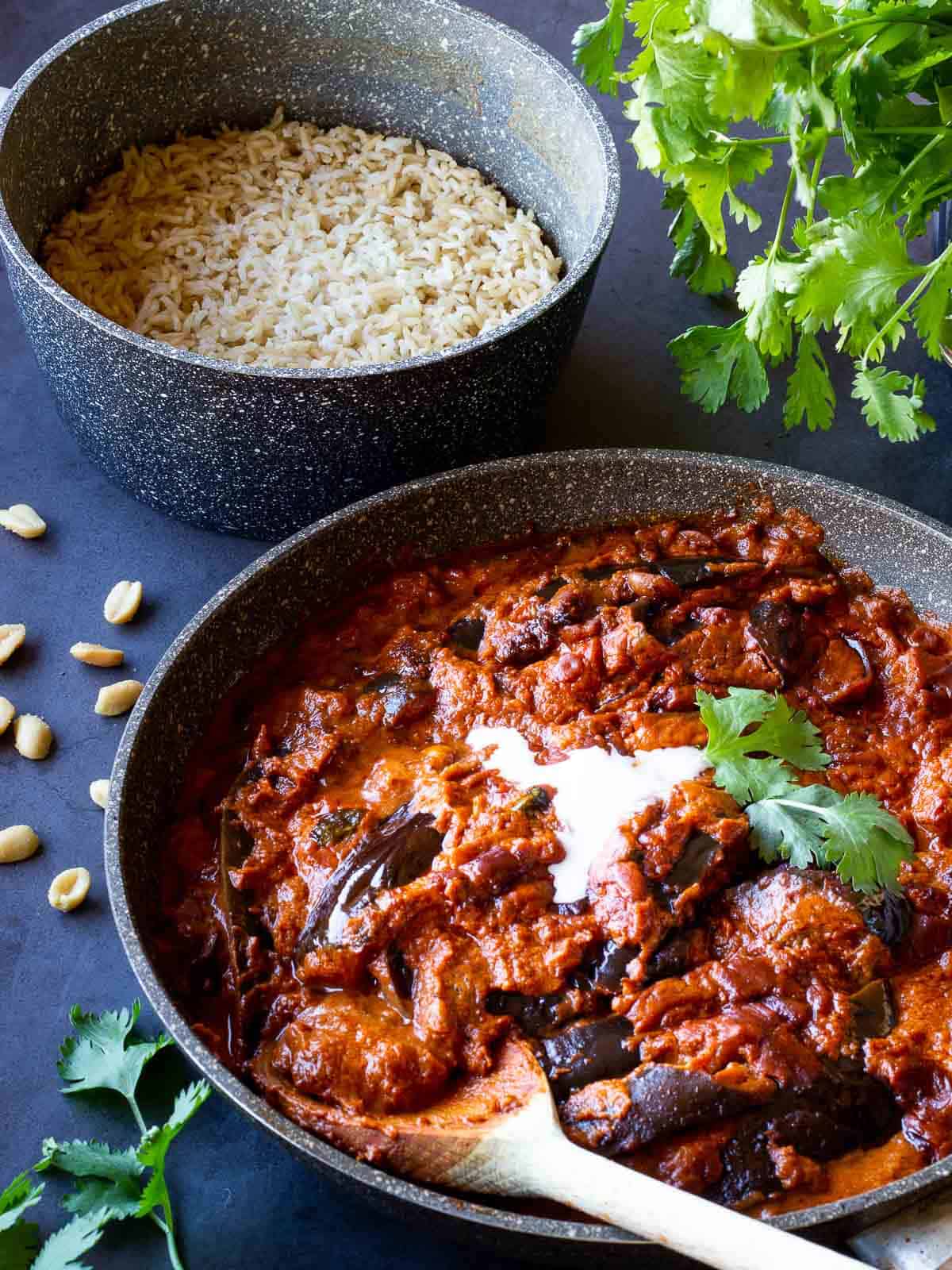
💡 Expert tips
Enhance the curry's richness by stirring two tablespoons of peanut butter while cooking and using full-fat coconut milk.
To reduce bitterness in eggplants, sprinkle them with coarse salt and let them rest on a wire rack over the sink for 15 minutes before use.
A personal favorite addition of ours is a tablespoon of freshly grated ginger, which really elevates the intensity and adds a vibrant zest.
While the idea of adding onions and garlic might be tempting, we found that they began to dominate the subtle, delicious flavors of the slow-roasted eggplant. So, we chose to omit them to let the eggplant's taste shine through.
📖 Variations
Our Go-To Spicy Twists: We often amp up our eggplant curry with some heat by adding sliced green chilies, or a teaspoon of red chili flakes, cayenne pepper, red chili powder, or green chili. It really brings a lively kick that we love.
We're also big fans of adding a teaspoon of crushed mustard seeds or black mustard seeds for their distinct flavor.
Also, if you have harissa paste, add a tablespoon or two. Harissa is a spicy North African chili paste with a complex flavor profile. It combines the heat of chili peppers with a smoky taste and subtle sweetness, enriched by garlic, caraway, coriander, cumin, and occasionally mint. Olive oil blends these elements into a smooth, rich paste.
Protein Boost: Want to up the protein? Toss in some cubed tofu or tempeh during the last 10 minutes of cooking. They'll soak up the flavors and add a different texture to the dish.
Low-Fat Version: If you're watching your calories, swap out the coconut milk for a lighter plant-based milk like almond or oat milk. Just add a teaspoon of cornstarch to thicken the sauce and you're good to go.
Bulk it up: Add medium diced potatoes and tomato puree to add some extra starch and volume to your curry. Also, you can add Frozen peas - add a handful if you want some extra texture and veggies.
🥢 How to serve
Basmati Rice: The long-grain, aromatic rice is a classic pairing with any Indian curry. It's like the Batman to this Eggplant Curry's Robin. The rice soaks up the flavors and provides a fluffy, light base that complements the richness of the curry. Ass some spicy spiced onions prepared with Indian spices; alternatively, serve with delicious vegan mashed potatoes.
Naan Bread: Tear off a piece of this fluffy, slightly charred bread and use it as an edible spoon. It's the perfect vehicle for scooping up that delicious curry and makes for a hearty meal.
Stuffed Bell Peppers: Get a little adventurous and stuff some bell peppers with the Eggplant Curry. Bake them until the peppers are tender, and you've got yourself a fusion dish that's as Instagrammable as it is tasty.
Serve with freshly made basmati rice, naan flatbread,
❓ FAQ
Garam masala is a blend of spices used in Indian cuisine, while curry powder is a British invention that combines different spices depending on the region.
Garam masala typically contains cumin, coriander, cardamom, cloves, cinnamon, and black pepper.
Curry powder can contain various spices such as turmeric, cumin, coriander, garam masala, mustard seeds, ginger, and chilies.
The flavor profiles of garam masala and curry powder vary significantly since each one contains different spice combinations. Curry powder is generally hotter and spicier than garam masala.
Ah, the age-old question: To salt or not to salt the eggplant and why.
Reduce Bitterness: Older eggplants can sometimes have a bitter taste. Salting them can help draw out some of that bitterness.
Remove Excess Moisture: Salting also helps remove excess moisture, resulting in a less soggy, more firm texture when cooking.
Our Take:
Given that many modern eggplant varieties are bred to be less bitter, salting is often optional. If you're using fresh, young eggplants, you can probably skip this step without any culinary regrets. However, if you're aiming for a firmer texture or are working with an older, potentially bitter eggplant, then go ahead and salt away!
So, it's your call! Whether you're Team Salt or Team No-Salt, you're still in for a delicious dish.
Curry can be traced back to the origins of India and Bangladesh - that is where it came from originally.
Curry was first brought into Britain by the British Raj (or British Empire), which ruled over India between 1858 and 1947.
The British Raj used a lot of spices in their cooking and brought them into Britain.
A popular spice that they introduced was called "curry powder," which is a mixture of many different spices.
When curry powder arrived in Britain, it was very new, so after a time, people began to add more and more spices to curry powder, giving rise to different varieties of curry.
Over time, people began to call the new combinations of spices "curry" and so curry powder itself was called "curry powder."
Curry is a dish that has many different varieties and origins. One popular type of curry is Thai curry, which originated in Thai cooking and uses Thai spices such as Thai basil, Thai chili, Thai lemongrass, Thai galangal (also called Thai ginger), and Thai fish sauce.
Indian curry is another type of curry that has many different varieties, such as roghan josh (the red roghan meaning red chili powder), korma (derived from the word "kurma"), vindaloo, and garam masala (which we use in this recipe).
🍛 More Curry Recipes
Creamy red lentil curry, a delicious quick meal.
This Thai Fresh vegan red curry, is perfect for a weekday meal.
This vegetarian Thai yellow Curry recipe, is my go-to recipe when I want to impress my guest with Thai cooking!
If you are wondering how to make a Green Thai Curry, you need to check this out to see all the tips!
If you like one-pot recipes, don't forget to try this vegan chili recipe! Your family will love it!
Into Indian recipes? This Ayurvedic vegan kitchari recipe is a great one for detoxing and giving your stomach some rest while resetting your gut health.
If you love eggplant, check our vegan eggplant recipes post for more delicious recipes and one of our favorite eggplant comfort foods, the savory eggplant pie, and our roasted eggplant pasta sauce with tomato and vegan ricotta cheese.
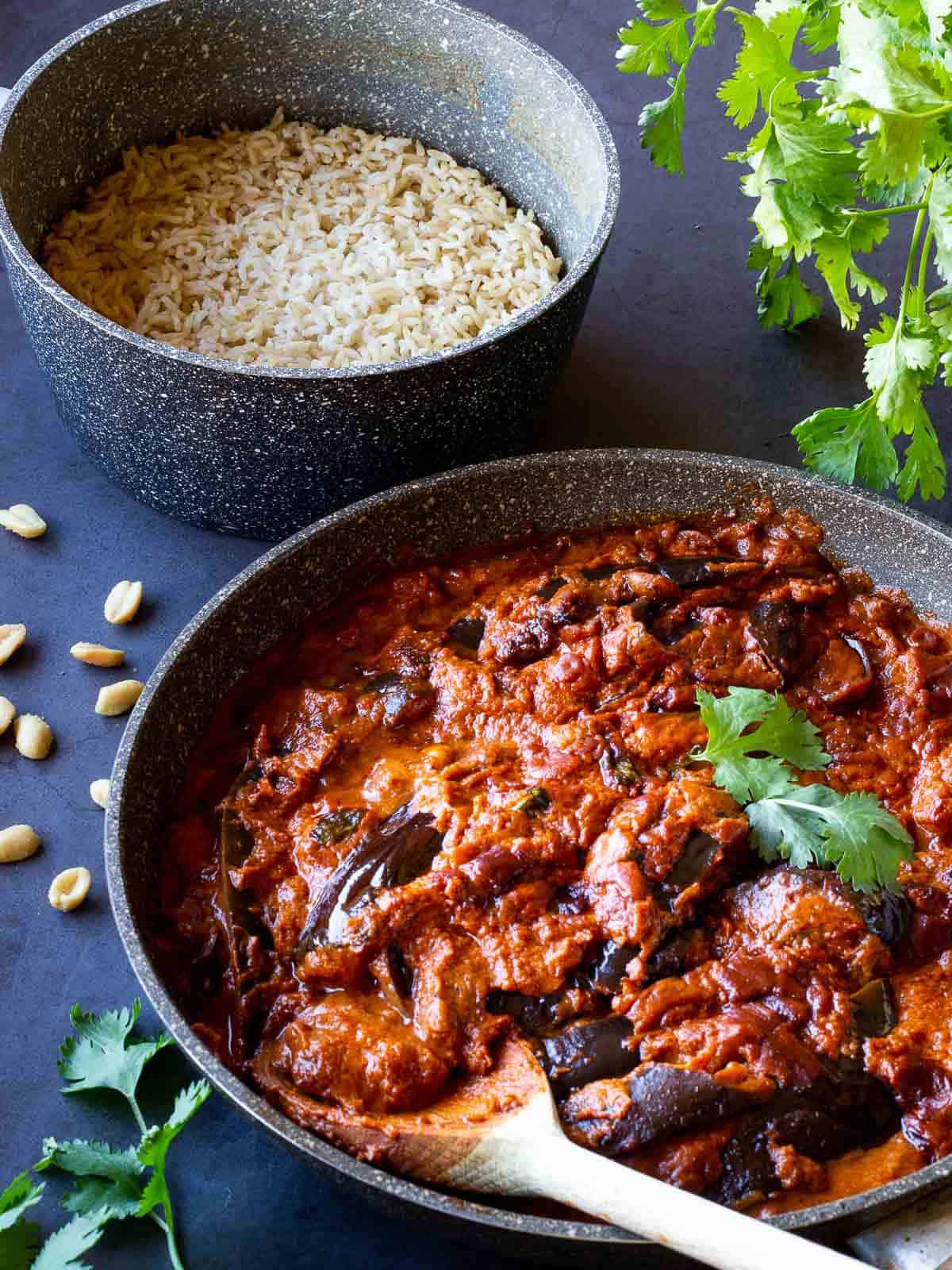
⭐ If you try this curry, let us know! 💬 Leave a comment, rate it, and don't forget to tag us @ourplantbasedworld on Instagram. Cheers!
And for even more recipes, join our Facebook Fan Page for support, inspiration & fun!
🎥 Video
📋 Recipe
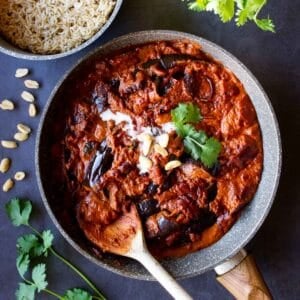
Indian Eggplant Curry Recipe
Equipment
Ingredients
- 1 eggplant big, or 2 small
- 3 tablespoons masala curry powder organic, or madras curry
- 1 tablespoons avocado oil or coconut oil
- 2 cups organic tomato sauce or 4 tomatoes diced
- ¼ cup peanuts you can leave out a couple to garnish
- ⅓ cup coconut milk (you can leave 2 tablespoons out to decorate)
- 1 bunch coriander or parsley leaves
- 1 cup water
Optional:
- ¼ cup coconut shredded or flakes optional
- 1 teaspoon sea salt
- ½ teaspoon cayenne pepper
- 2 tablespoons peanut butter
To serve:
- 1 cup brown basmati rice organic, boiled
Directions
- Slice the eggplant lengthwise. Ensure to make thick slices of about ½ inch (1 cm).
- In a large saucepan, gently toast the peanuts along with the shredded coconut on medium-high. Make sure they only get golden; it should take about 30 seconds.
- Add the oil and the curry and stir for 1 minute.
- Stir in the half of the tomato purée and stir for 2 minutes.
- Place the eggplant slices on top of the mix. Stir a bit and add 1 cup of water. Close with a lid. (don’t worry if the eggplants are not fully covered). Bring the heat to the minimum and leave it closed for 30 minutes.
- Stir. Open the lid, stir a bit and add the coconut milk, the rest of the tomato purée and the salt and cayenne pepper (salt and pepper are optional).
- After 10 minutes, add half of the chopped coriander (reserve the rest to garnish). With the back of the spoon, slightly mash the eggplant slices inner parts. Close the lid and let it simmer for another 10 minutes, stirring it halfway through.
- Turn the heat off and garnish. Your curry is ready to serve with some basmati rice. Garnish with the remaining coriander leaves.
Video
Notes
Nutrition Facts
Nutritional Disclaimer
The information shown is an estimate provided by an online nutrition calculator. It should not be considered a substitute for a professional nutritionist's advice. See our full Nutritional Disclosure here.
Affiliate Disclaimer
Please note that some of the links here are affiliate links, and I will earn a commission if you purchase through those links. I recommend all of the products listed because they are companies I have found helpful and trustworthy.
As the lead content writer and recipe developer at Our Plant-Based World, he combines his passion for health and sustainability with a Plant-Based Nutrition Certification to create accessible, delicious vegan recipes. His expertise in plant-based cooking supports the blog's mission of fostering a healthier, environmentally conscious lifestyle through simple and seasonal dishes. His commitment to making vegan cooking enjoyable and inclusive for everyone shines in each recipe and article.

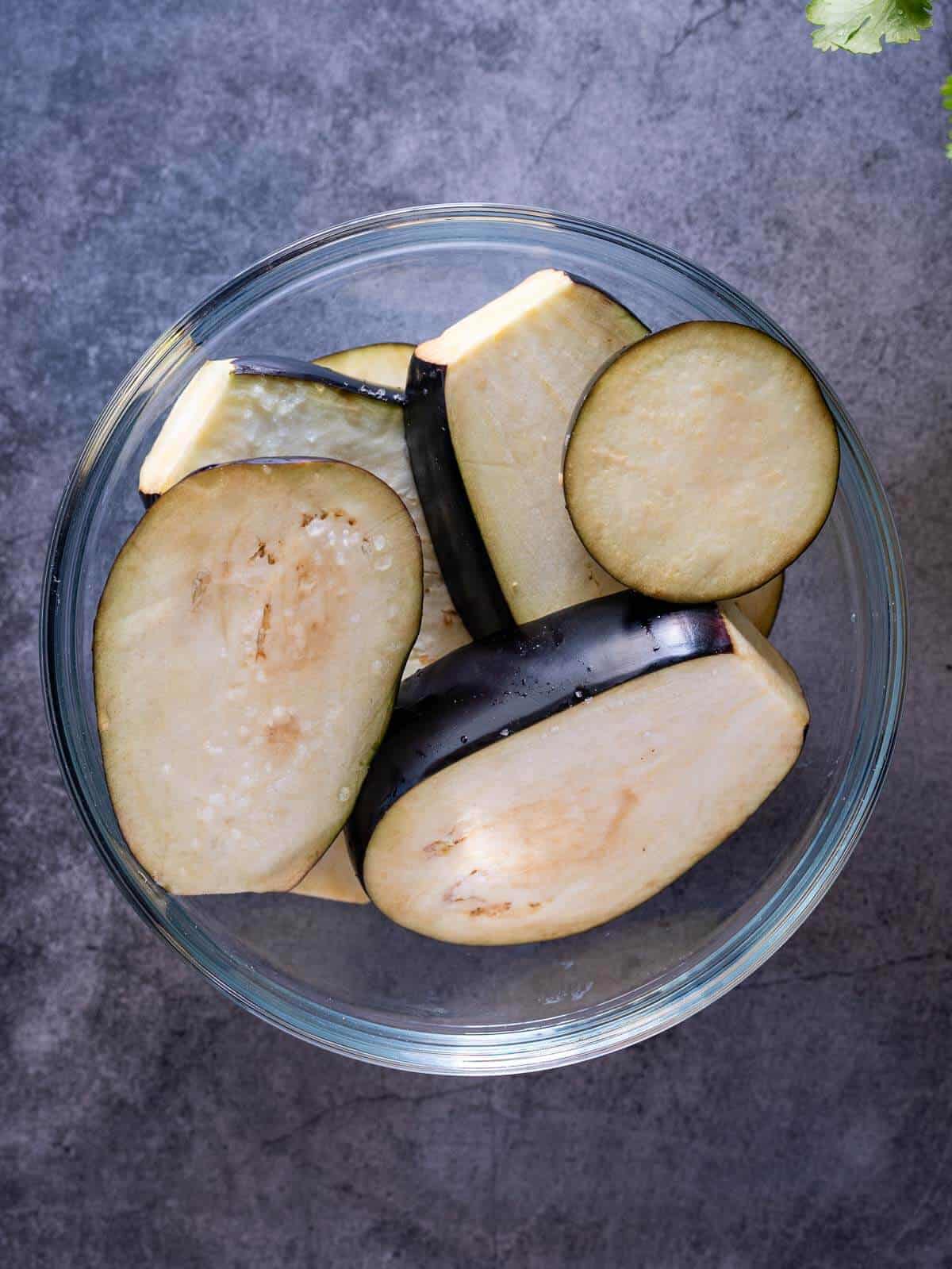
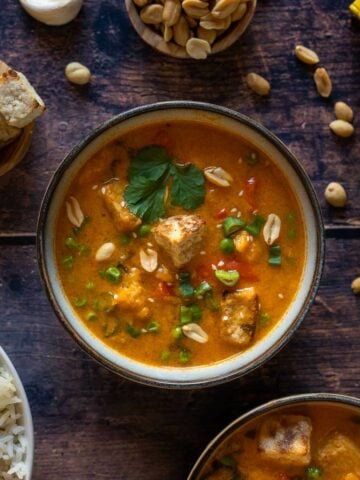
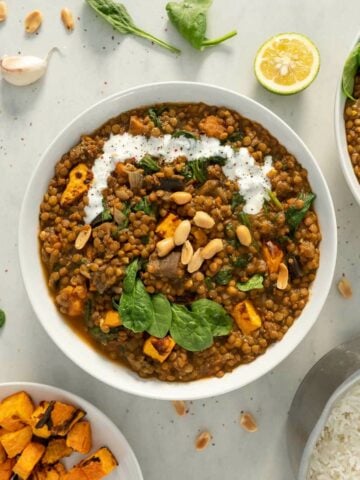
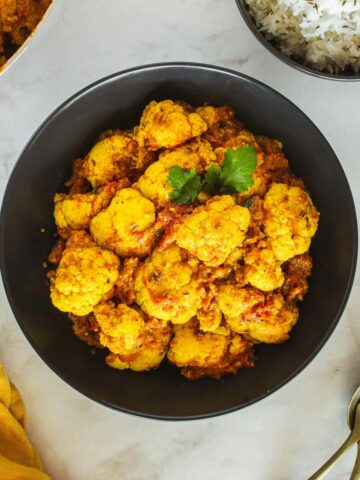
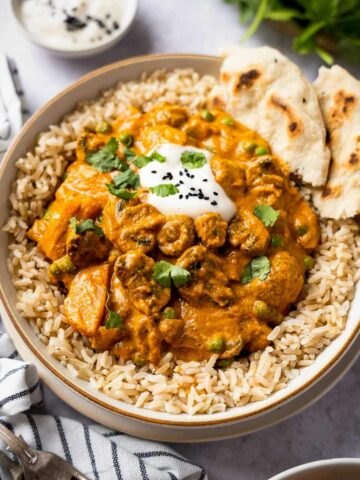
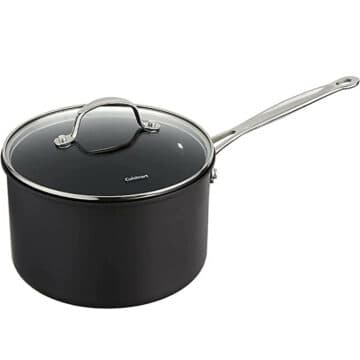



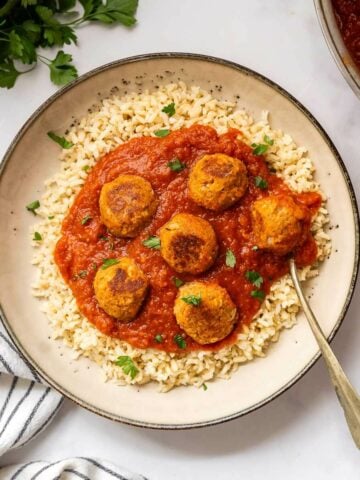
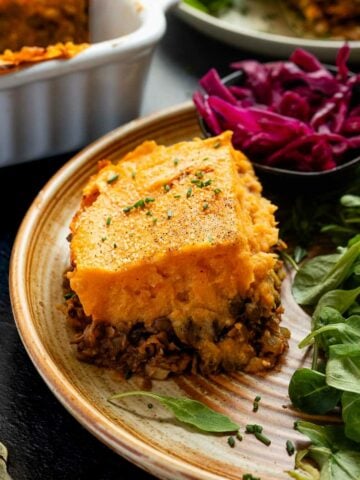
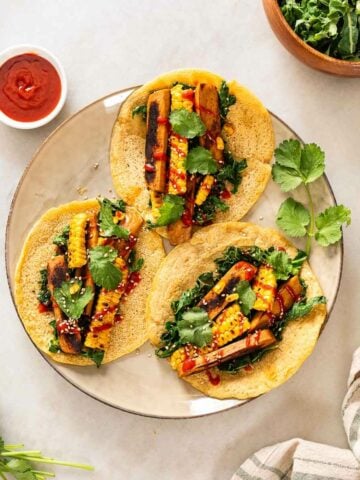
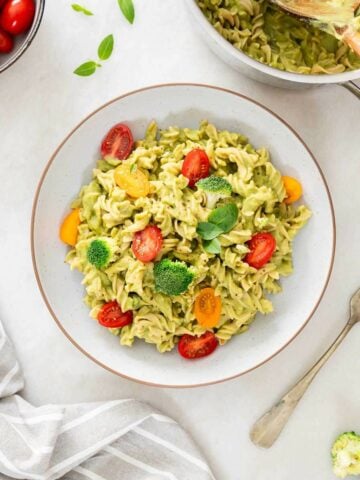
Melissa
We have a peanut allergy in the house - can you recommend a substitution?
Gus
Hi Melissa, thank you for your inquiry. You could substitute peanuts with walnuts or blanched almonds. You can safely eat seeds if you're allergic to peanuts and other tree nuts. Popular substitutes include pumpkin seeds and sunflower seeds. I hope it helps and please let me know which one you choose and how you like it.
Savita
This looks full of flavors. A-must try dinner recipes
Gus
Thank you for your review, Savita. I'm glad to hear that the recipes look full of flavors and are a must-try! We have lots more where those came from so be sure to browse our site and subscribe to receive updates on new recipes.
Rachna
I love eggplants and this curry looks and sounds delicious. Thanks for sharing.
Jessica
Oh this is so good with naan!!
Heidy
This Eggplant Indian Curry was excellent tasting. Definitely, a comfort food the whole family loved. Saving to make again.
Gus
Thanks for your review Heidy! I am glad the recipe was a hit on your family table!
Pam
We grow eggplant in the garden every year and I'm always looking for new recipes to make with it. This will be fabulous!
Gus
Thanks Pam! I'm so glad you found the recipe helpful. If you have any other questions, please don't hesitate to reach out.
Irena
Aubergine, eggplant, whatever you call it, it's bloody delicious! This is a fantastic curry, guys. Thanks for the recipe, really enjoyed it.
Gus
That's cool Irena! We are glad you enjoyed this fav of ours!
Kate
This egg plant curry was amazing! I served mine with some roti and it was amazing. Thank you!!
Gus
Roti is a great way to have it, I am sure it was delish! 🙂 Thanks for stopping by!
Jessie
I am a huge Indian curry lover, but I’m always a little intimidated to make them myself. This recipe was really well written and the results were delicious!
Gus
Thank you, Jessie! I am glad you found it easy to make and yummy!
Denay DeGuzman
What a delicious eggplant curry. I've already shared this recipe with 2 friends. Everyone's enjoying it! This recipe's a keeper.